The best tea blends combine herbs that complement each other in flavor and health benefits. You'll find chamomile pairs well with lavender for relaxation, while peppermint blends with citrus for an energizing kick. Echinacea mixes boost immunity, especially when combined with elderberry or ginger. For a soothing experience, try lavender with chamomile or mint. Spice things up with ginger-infused concoctions like turmeric golden milk or chai. Lemon balm offers invigorating fusions, and hibiscus provides antioxidant-rich blends. Don't forget fennel for digestive aid or holy basil for stress relief. Exploring these combinations will open up a world of delightful and beneficial herbal tea experiences.
Calming Chamomile Combinations

Blending chamomile with other herbs can create a powerful, soothing tea experience. This gentle flower pairs well with several complementary ingredients to enhance its calming effects.
You'll find that lavender is an excellent companion, adding a floral note and boosting relaxation. For a touch of sweetness, consider mixing in some lemon balm or mint, which can also aid digestion.
If you're looking to deepen the flavor profile, try adding a small amount of rose petals or hibiscus. These additions will introduce a subtle tartness and vibrant color to your blend.
For those who enjoy earthy tones, valerian root or passionflower can intensify the tea's sedative properties, making it perfect for nighttime consumption.
Don't forget about spices. A pinch of cinnamon or ginger can warm up your chamomile blend, especially during colder months.
If you're aiming for a more complex taste, experiment with fennel seeds or star anise. These ingredients not only enhance flavor but also contribute additional health benefits.
Remember to start with small quantities and adjust according to your preferences, as some herbs can overpower chamomile's delicate taste.
Energizing Peppermint Blends
For an invigorating cup, you'll love energizing peppermint blends that wake up your senses.
Try combining peppermint with citrus fruits like lemon or orange for a zesty, revitalizing taste that's perfect for starting your day.
If you're looking for an extra boost, consider adding ginseng to your peppermint tea for a natural energy kick that'll keep you going strong.
Peppermint and Citrus Combinations
Bursting with invigorating flavors, peppermint and citrus combinations create energizing tea blends that'll wake up your senses. The cool, revitalizing taste of peppermint pairs perfectly with the bright, zesty notes of citrus fruits. This dynamic duo offers a natural energy boost without the jitters of caffeine.
To create your own peppermint and citrus tea blend, consider these popular combinations:
- Peppermint and lemon balm
- Peppermint and orange peel
- Peppermint, lemongrass, and lime
- Peppermint, grapefruit, and rosemary
- Peppermint, tangerine, and ginger
These blends not only taste delicious but also offer numerous health benefits. Peppermint aids digestion and relieves headaches, while citrus fruits are packed with vitamin C and antioxidants. Together, they can help boost your immune system and improve mental clarity.
When brewing your peppermint and citrus tea, use fresh or dried herbs and fruits for the best flavor. Steep for 5-7 minutes in hot water, then strain and enjoy.
You can drink these blends hot or iced, making them perfect for any season. Experiment with different ratios to find your ideal balance of minty and citrusy notes.
Ginseng Peppermint Energy Boost
Peppermint's energizing properties don't stop at citrus combinations. When paired with ginseng, you'll get a powerful energy-boosting blend that's perfect for those mid-afternoon slumps.
Ginseng, known for its adaptogenic qualities, complements peppermint's invigorating nature, creating a tea that'll wake you up without the jitters of caffeine.
To make this energizing blend, combine equal parts dried peppermint leaves and ginseng root. You can add a touch of stevia or honey if you prefer a sweeter taste. Steep the mixture in hot water for 5-7 minutes, allowing the herbs to release their beneficial compounds.
This ginseng-peppermint combo offers more than just an energy boost. It may help improve mental clarity, reduce stress, and support your immune system.
The cooling effect of peppermint can also aid digestion, while ginseng might enhance your body's ability to handle physical and mental stress.
For an extra kick, try adding a pinch of ginger or a few green tea leaves to your blend. These additions will further amplify the energizing effects and introduce new flavor dimensions to your cup.
Immune-Boosting Echinacea Mixes

Echinacea stands out as a powerful ally in the world of immune-boosting herbal teas. It's renowned for its ability to stimulate the immune system and help fight off colds and flu.
When creating echinacea-based tea blends, you'll want to pair it with complementary herbs that enhance its effects and improve flavor.
Consider these immune-boosting echinacea mixes:
- Echinacea and elderberry: A potent combination that supports overall immune health
- Echinacea, ginger, and lemon: Adds warmth and vitamin C to the blend
- Echinacea and rosehip: Provides an extra dose of vitamin C and a tart flavor
- Echinacea, lemongrass, and honey: Creates a soothing, sweet blend with antimicrobial properties
- Echinacea and licorice root: Offers a natural sweetness and additional immune support
When brewing these blends, steep for 5-10 minutes to extract the maximum benefits. You can enjoy these teas hot or iced, depending on your preference.
Remember to consult with a healthcare professional before incorporating echinacea into your routine, especially if you're pregnant, nursing, or have autoimmune disorders.
Soothing Lavender Tea Creations
You'll find lavender to be a versatile and calming addition to your tea blends.
Try combining it with chamomile for a soothing bedtime brew that promotes relaxation and better sleep.
For a revitalizing twist, mix lavender with mint to create an invigorating yet calming infusion perfect for unwinding after a long day.
Lavender-Chamomile Calming Blend
When it comes to unwinding after a long day, few tea blends can match the soothing power of lavender and chamomile. This calming combination offers a gentle, floral aroma and a mild, sweet taste that's perfect for relaxation.
You'll find that the lavender's subtle, herbaceous notes complement the apple-like flavor of chamomile beautifully.
To create your own lavender-chamomile blend, you'll need:
- Dried chamomile flowers
- Dried lavender buds
- A tea infuser or disposable tea bags
- Hot water
- Optional: honey or lemon for added flavor
Start by mixing equal parts chamomile and lavender, or adjust the ratio to suit your taste preferences. Use about 1-2 teaspoons of the blend per cup of hot water and steep for 5-7 minutes.
You'll notice the water taking on a golden hue as the herbs release their calming properties. This blend isn't just delicious; it's also known for its potential to reduce anxiety, improve sleep quality, and ease digestive discomfort.
Enjoy this soothing tea before bedtime to promote restful sleep or any time you need a moment of tranquility in your day.
Lavender-Mint Relaxation Infusion
Building on the calming properties of lavender, let's explore another soothing blend that pairs this versatile herb with invigorating mint. This combination creates a unique balance between relaxation and refreshment, making it perfect for unwinding after a long day or as a pre-bedtime ritual.
To create this infusion, you'll need dried lavender buds and fresh mint leaves. Start by bringing water to a near-boil and steeping a teaspoon of lavender buds for 3-5 minutes. Then, add a handful of fresh mint leaves and let them steep for an additional 2-3 minutes. The result is a fragrant, light-bodied tea with a delicate floral aroma and a cool, minty finish.
The lavender in this blend promotes relaxation and may help reduce anxiety, while mint aids digestion and provides a subtle energy boost. Together, they create a harmonious blend that soothes your mind without making you feel drowsy.
You can adjust the ratio of lavender to mint based on your preference, adding more lavender for a stronger floral note or increasing the mint for a more invigorating experience.
Ginger-Infused Spicy Concoctions
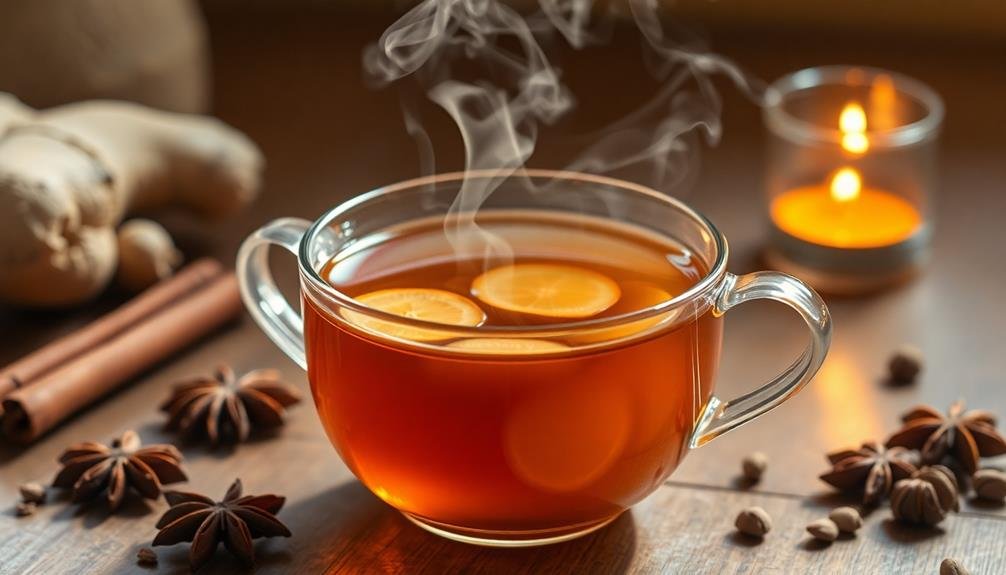
Ginger-infused spicy concoctions offer a delightful kick to your tea repertoire. This zesty root adds warmth and complexity to your blend, creating a bold and invigorating experience.
You'll find that ginger pairs well with a variety of herbs and spices, allowing you to craft unique and flavorful combinations.
To create your own ginger-infused spicy tea blends, consider these exciting options:
- Ginger-Turmeric Golden Milk: Combine ginger with turmeric, black pepper, and cinnamon for a powerful anti-inflammatory brew.
- Spicy Chai: Mix ginger with black tea, cardamom, cloves, and star anise for a classic Indian-inspired blend.
- Lemon-Ginger Zing: Blend ginger with lemongrass, citrus peel, and a touch of cayenne for a revitalizing cup.
- Ginger-Cinnamon Comfort: Pair ginger with cinnamon, nutmeg, and a hint of vanilla for a cozy, warming drink.
- Ginger-Peppercorn Kick: Combine ginger with various peppercorns and a dash of chili flakes for an extra spicy brew.
When working with ginger, remember that a little goes a long way. Start with small amounts and adjust to your taste preferences.
You can use fresh ginger root, dried ginger pieces, or powdered ginger in your blends, depending on your desired intensity and convenience.
Refreshing Lemon Balm Fusions
Lemon balm's citrusy-mint aroma offers a rejuvenating twist to your tea blends. This versatile herb pairs well with various ingredients, creating invigorating fusions that'll awaken your senses. You'll find its bright flavor complements both hot and iced teas, making it perfect for year-round enjoyment.
To create delightful lemon balm fusions, consider these popular combinations:
| Base Tea | Complementary Herb | Flavor Profile |
|---|---|---|
| Green Tea | Mint | Cool and invigorating |
| White Tea | Lavender | Floral and calming |
| Black Tea | Ginger | Spicy and uplifting |
| Rooibos | Chamomile | Soothing and mellow |
| Oolong | Rose Petals | Fragrant and complex |
When brewing lemon balm tea, use fresh or dried leaves. Steep 1-2 teaspoons of dried leaves (or 2-3 fresh leaves) in hot water for 5-7 minutes. For a stronger flavor, increase steeping time or add more leaves. You can also cold brew lemon balm tea by steeping it in cold water for 4-6 hours in the refrigerator. Experiment with different ratios and combinations to find your perfect blend.
Antioxidant-Rich Hibiscus Blends

Hibiscus tea stands out for its vibrant color and tart flavor, packed with antioxidants that boost your health.
It's a versatile herb that blends well with other ingredients, creating delicious and nutritious combinations. You'll find that hibiscus-based blends offer a perfect balance of taste and wellness benefits.
To create your own antioxidant-rich hibiscus blends, try mixing it with:
- Rosehips for added vitamin C
- Lemongrass for a citrusy twist
- Ginger for warmth and digestive support
- Mint for a rejuvenating coolness
- Cinnamon for a touch of sweetness and spice
These combinations not only enhance the flavor profile but also increase the overall antioxidant content of your tea.
You'll enjoy the bright, fruity notes of hibiscus while reaping the benefits of its powerful antioxidants. Regular consumption of hibiscus blends may help lower blood pressure, support heart health, and boost your immune system.
Don't be afraid to experiment with different ratios and additional herbs to find your perfect blend.
Digestive-Aiding Fennel Combinations
Fennel, with its distinctive licorice-like flavor, offers numerous digestive benefits when used in tea blends. You'll find it particularly effective in soothing an upset stomach, reducing bloating, and easing indigestion.
To create a powerful digestive aid, combine fennel with other stomach-friendly herbs like peppermint or ginger.
For a calming after-dinner blend, mix equal parts fennel and chamomile. This combination not only aids digestion but also promotes relaxation.
If you're looking to boost your tea's anti-inflammatory properties, pair fennel with turmeric and a pinch of black pepper. This blend can help reduce inflammation in the digestive tract.
For a revitalizing and digestive-friendly iced tea, combine fennel with lemon balm and a touch of honey. You'll enjoy a cooling drink that also supports your gut health.
If you're dealing with nausea, try a blend of fennel, ginger, and lemon verbena. This potent combination can help settle your stomach and alleviate queasiness.
Stress-Relieving Holy Basil Mixes
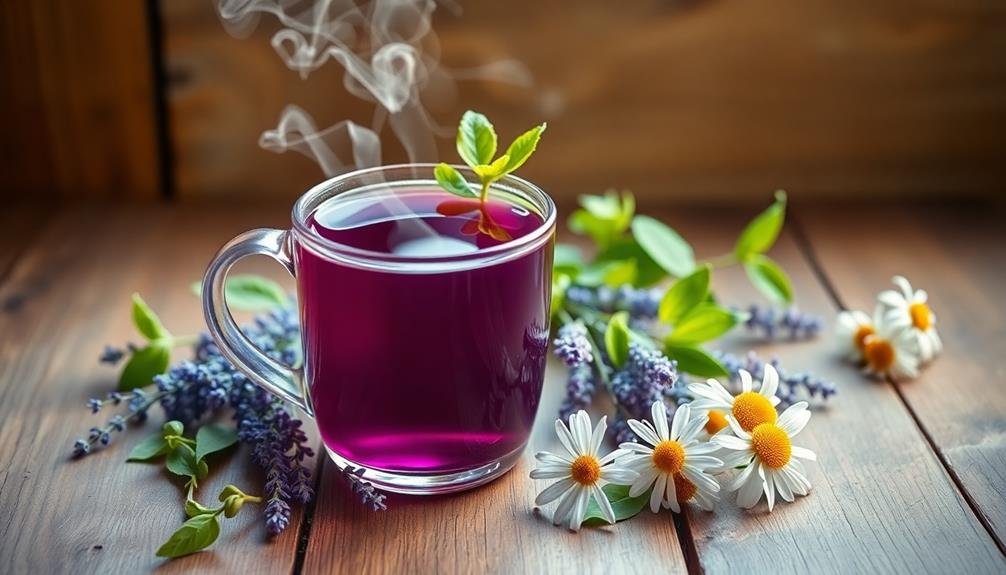
While fennel excels in aiding digestion, holy basil shines as a stress-relieving powerhouse in tea blends. Also known as tulsi, this adaptogenic herb helps your body cope with stress and promotes overall well-being.
You'll find that holy basil's slightly peppery, clove-like flavor pairs well with various herbs and spices, creating delicious and calming tea combinations.
To create stress-relieving holy basil mixes, consider blending it with:
- Chamomile for enhanced relaxation
- Lavender to promote better sleep
- Lemon balm for mood improvement
- Peppermint to boost mental clarity
- Ginger for added warmth and digestive benefits
When brewing your holy basil blend, use about 1 teaspoon of the herb mixture per cup of hot water. Let it steep for 5-10 minutes, depending on your desired strength.
You can enjoy these calming blends throughout the day, but they're especially beneficial in the evening to help you unwind.
Don't hesitate to experiment with different ratios and additions to find your perfect stress-relieving tea blend.
Frequently Asked Questions
How Long Should Herbal Tea Blends Be Steeped for Optimal Flavor?
You'll want to steep your herbal tea blends for 5-10 minutes. It's best to start with 5 minutes, then taste and adjust. Don't over-steep, as it can make your tea bitter. Experiment to find your perfect brew time.
Can I Mix Herbs With Regular Black or Green Tea?
Yes, you can mix herbs with black or green tea. It's a great way to create unique flavors. Try adding mint, lavender, or ginger to your regular tea. You'll discover exciting new combinations and health benefits.
Are There Any Herbs That Shouldn't Be Combined in Tea Blends?
You should avoid combining certain herbs in tea blends. Don't mix stimulating herbs with sedatives, or blood thinners with coagulants. Be cautious with potent herbs like comfrey or licorice root, and always research potential interactions before blending.
How Should I Store My Herbal Tea Blends to Maintain Freshness?
You'll want to store your herbal tea blends in airtight containers, away from light, heat, and moisture. Keep them in a cool, dark place like a pantry. Don't forget to label them with the blend name and date.
Are There Any Potential Side Effects of Drinking Herbal Tea Blends Regularly?
You should be aware that some herbal teas can cause side effects. They may interact with medications, trigger allergies, or impact pregnancy. It's best to consult your doctor if you're drinking them regularly or have health concerns.
In Summary
You've now explored a variety of herbal tea blends, each offering unique flavors and health benefits. Whether you're seeking relaxation, energy, or immune support, there's a perfect blend waiting for you. Don't be afraid to experiment with different combinations to find your favorites. Remember, the best tea blend is one that suits your taste and needs. So grab your kettle, steep some herbs, and enjoy the soothing ritual of a perfect cup of herbal tea.

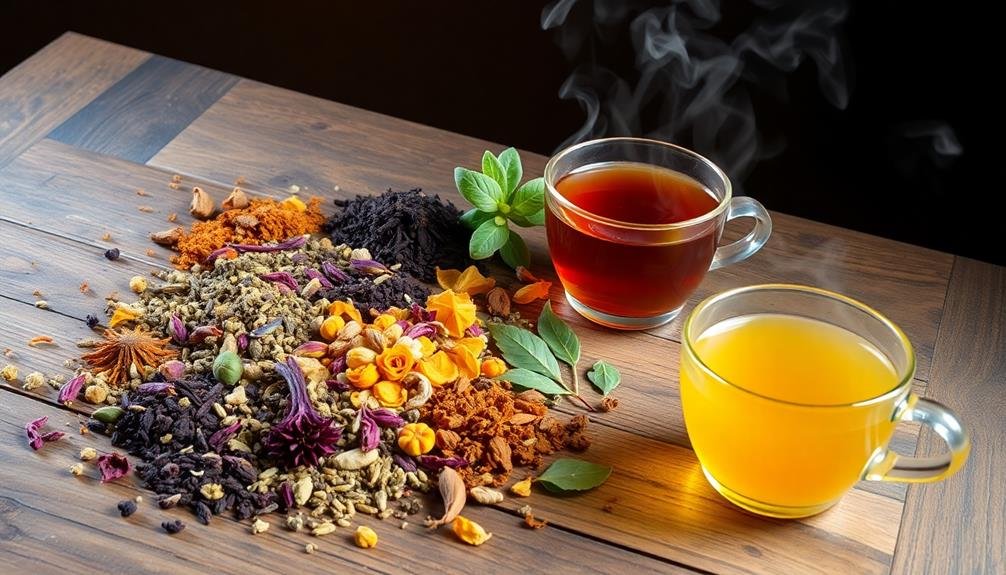
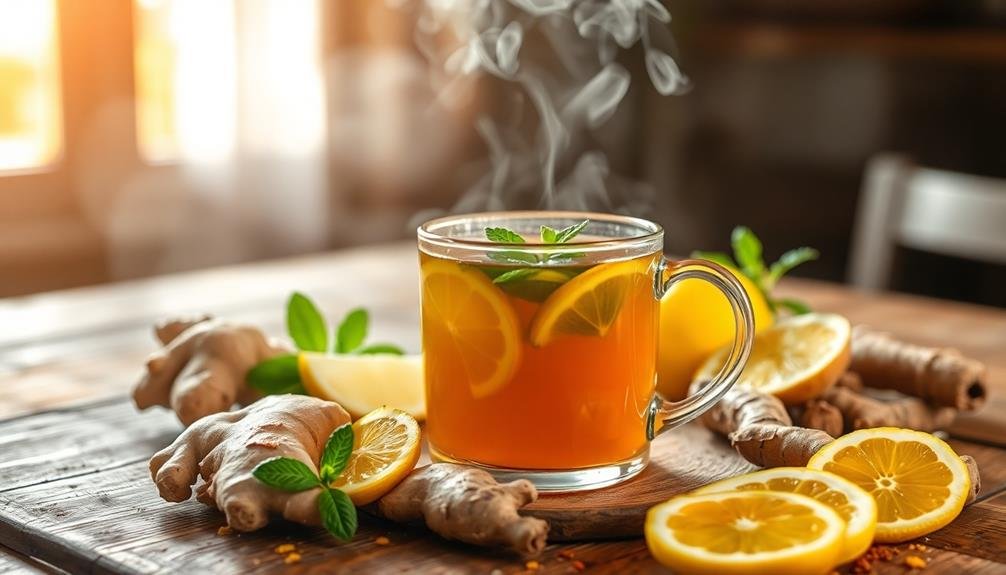
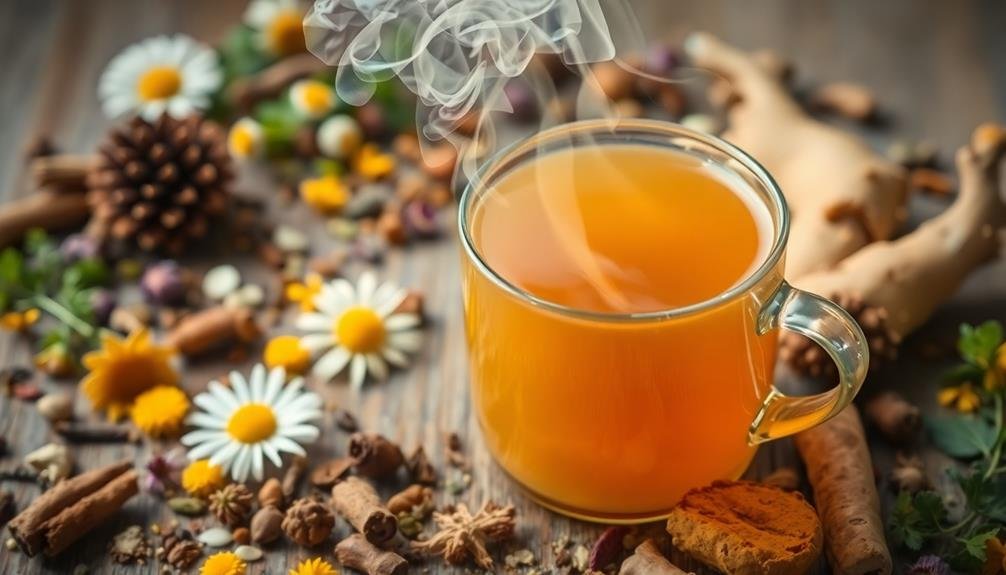
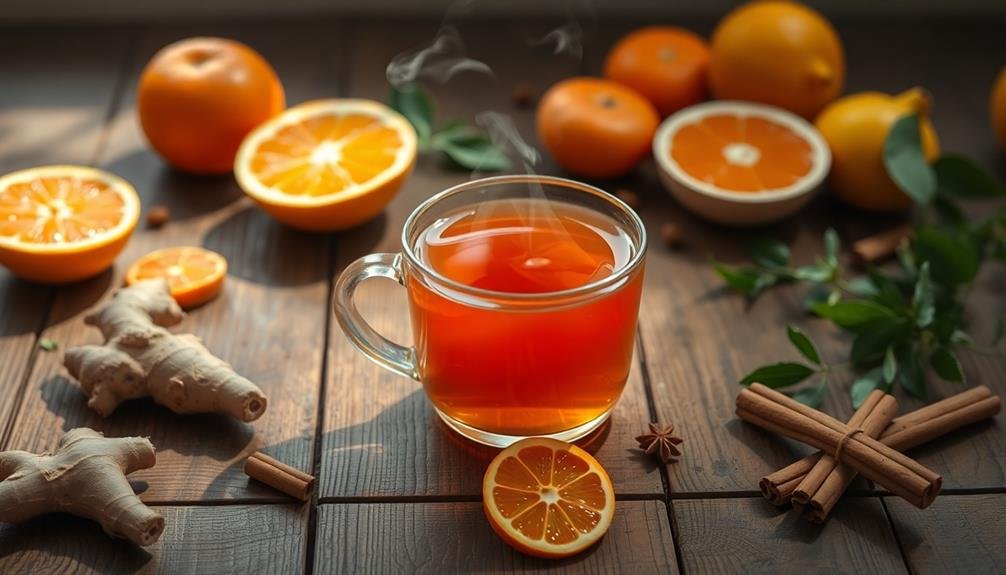
Leave a Reply